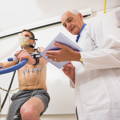Want to Speed Up Exercise Recovery? Here's What You Need to Know
0 Comments
Want to Speed Up Exercise Recovery? Here's What You Need to Know

Your rest days are equally important as your workout sessions.
Surprised?
However, many athletes believe that breaks are unnecessary and feel guilty when they take a day off. But taking breaks is essential for recovery and performance. And they aren’t just for athletes either. Anyone who sticks to a systematic fitness routine should consider incorporating rest days for the best outcomes.
Gone are the days of the "no pain, no gain" mantra. Recent scientific studies are revealing that prioritizing post-workout recovery is just as crucial, if not more so, than the time spent on training.
But are you confused about how to speed up your exercise recovery and get back to your routine faster?
No worries.
Here’s everything you need to know to make the most out of your rest days.
Why is Workout Recovery So Important?
Thinking of your workout as a muscle growth session? It's time to reconsider. Contrary to popular belief, muscles don't grow while exercising; they grow during periods of rest in between sessions. This is because exercise creates stress on the body, which, when repeated, helps the body adapt and respond to the stimulus.
Exercise – particularly intense exercise – creates micro-tears in the muscle fibers. Failing to give your muscles adequate time to heal from micro-tears can result in inflammation, swelling, and exhaustion of the muscles.
Furthermore, insufficient recovery time can cause decreased performance and even lead to overtraining syndrome (OTS), a condition that compromises the immune system, causes exhaustion, and leads to chronic joint and muscle pain.
If you exercise so hard, you’d probably know the term Delayed Onset Muscle Soreness (DOMS). DOMS is the natural response by the body and typically appears 12-24 hours post-exercise. This type of soreness is actually a signal from your body indicating that you need to rest before engaging in exercise again.
The importance of recovery in the workout process cannot be overstated. Recovery not only helps you avoid negative side effects, but when micro-tears heal, it promotes muscle growth.
Know the Benefits of Rest and Recovery
Here’s how rest and recovery let your muscles heal and make you stronger and fitter.
Enhances Your Muscle Recovery
Exercise depletes muscle glycogen (energy stores of the body) and causes muscle-tissue breakdown. Giving adequate recovery time allows the body to replenish energy stores and repair damaged tissues. If you don’t give your muscles sufficient time to recover from damage, your performance could be affected, and you’re more likely to experience muscle soreness and pain[3].
Helps You Control Adaptation
Have you heard of the Principle of Adaptation? It refers to the physiological response of the body to repeated stress or exercise. The body adapts to a given stress level and becomes more efficient at handling that stress, resulting in improved physical performance. However, there is a limit to how much stress the body can handle before it becomes injured or damaged. Excessively increasing workload can lead to injury or muscle damage, while progressing too slowly may not yield any improvement. So it’s important to plan the intensity and duration of the workout while also incorporating rest days.
Restrains Overtraining
Overtraining can be prevented by ensuring sufficient rest and recovery days. Overtraining syndrome is a prevalent condition affecting approximately 60 percent of elite athletes and 30 percent of non-elite endurance athletes, and it can be challenging to recover from once developed. Overtraining can have multiple adverse effects on the body, including an increase in body fat, dehydration, reduced libido, and worsened mood.
Improves Relaxation
In addition to giving your body a much-needed break, taking a rest day can also provide a mental break and help prevent an overcrowded schedule. You can use your free time to engage in hobbies or spend quality time with family and friends. Maintaining a healthy lifestyle requires balancing your time between work, home, and fitness routine, and a rest day allows you to focus on other areas while also allowing your body to recover fully from the exercise sessions.
How Long It Takes to Recover?
The general recommendation is to take a 48-hour break between sessions to allow your muscles to heal and prevent soreness from affecting your future performance.
The following are some factors affecting exercise recovery:
Age: As you get older, your physiological processes slow down; so does your recovery. Younger individuals may recover more quickly than older individuals.
Intensity: The intensity of your exercise can affect your recovery time. The harder you work out, the longer it takes for recovery.
Diet: You are what you eat. For your body to recover, a balanced diet is so important. Consuming the right nutrients is essential, and you should prioritize a diet rich in fruits, vegetables, lean protein, omega-3 fatty acids, vitamin A, vitamin C, zinc, calcium, and other essential nutrients. This will provide your body with the required fuel to heal and recover efficiently.
Sleep: Sleep is crucial for muscle-tissue recovery and repair between workout sessions. Besides, it plays a crucial role in providing the necessary energy for exercise. Sleep deprivation can lead to reduced physical activity during the day and decreased muscle strength during workouts.
Stress: You should never underestimate the impact of stress on every aspect of life, including recovery. When it comes to stress, exercise has a dual role. We all know the psychological benefits of exercise. The feel-good hormones produced by exercise can boost your mood. On the flip side, exercise places stress and strain on the body. While you may feel physically fine, a high-intensity workout may not be the best way to relieve stress if you're already dealing with significant stressors.

Accelerate Wellness, Physical Endurance, and Mental Clarity
Get your Turbo Oxygen System, the Ultimate EWOT System in Body Conditioning & Self-Healing.
Confused About When to Take a Rest Day?
The number of rest days varies depending upon 2 factors: the type and the intensity of your exercise. According to American Council on Exercise (ACE), a good rule of thumb for high-intensity physical activity routines is to schedule a rest day every seven to ten days of activity[4]. Some workout schedules demand rest days more often, say, twice a week. You can follow a passive routine on one day, which gives you a complete break from exercise, and on the other day, you can focus on active recovery by doing some light-intensity exercises.
What Can You Do to Speed Up Your Recovery?
Read on to find out how you can reduce your recovery time and resume your workout routine quickly.
1. Consider Active Recovery Workouts
Active recovery allows your body to regenerate the tired muscles after an intense workout session. Active recovery refers to some sort of low-intensity exercise that helps your body recover from a high-intensity training schedule and is best suitable for someone who doesn’t want to completely stop or slow down their workout routine. It allows the muscles to recover while still staying active.
This type of recovery involves lighter forms of movement that work the muscles but at a lower intensity. Here are some suggestions: walking, swimming, biking, yoga, and so on. Incorporating active recovery on rest days can speed up recovery and prevent the need for complete rest.
2. Prioritize Sleep
Sleeping may seem counterintuitive when you're striving to improve your endurance, speed, or muscle size. Growth hormones are primarily released during sleep, which contributes to muscle mass gain.
Now it makes sense, right?
Additionally, sufficient sleep can decrease the likelihood of sustaining an injury, making it a helpful means of safeguarding yourself once you've recuperated and are prepared to resume your exercise regimen.
3. Try Adding a Cool-down Period
You probably know the importance of a warm-up period for a well-rounded exercise session. But what about a cool-down period? This cool-down period can consist of 5-10 minutes of low-impact or slower exercise to allow the body to gradually return to its normal physiological level. It is equally important to reduce the risk of injury and promote faster recovery.
Try to finish your workout session with a cool-down period, and you’ll feel the difference!
4. Incorporate Stretching into Your Fitness Routine
Stretching is an effective way to alleviate tightness and reduce post-exercise soreness. It can also help maintain muscle flexibility.
Although many athletes incorporate stretching into their cool-down routine, you can also stretch on days when you're not exercising to keep your muscles flexible. To reap the maximum benefits, include movements that engage all of your body's primary muscle groups in your stretching routine. Avoid overexertion and stop immediately if you experience any pain.
5. Consume a Balanced Diet
It's crucial to focus on your nutritional well-being, yet many people neglect it or place it at the bottom of their to-do list when it should be at the top.
A balanced diet is critical. Eating nutritious foods will supply your body with the fuel it requires for training and the vital nutrients needed for speedy muscle recovery between sessions. Studies[9] have revealed that consuming a snack or beverage with a carbohydrate-to-protein ratio of 3–4:1 within 30 to 45 minutes post-workout can help you recover and prepare you for the next day’s workout.
6. Stay Hydrated
Hydration plays a significant role in recovery. Drinking an ample amount of water not only aids in recovery but also enhances your overall health, alertness, and performance during training.
According to the recommendations of the National Academy of Medicine[10], it is suggested that healthy men and women should aim for a daily fluid intake of about 13 cups and 9 cups, respectively. Note that 1 cup is equivalent to 8 ounces. Higher amounts may be needed for those who are physically active or exposed to very warm climates.
Getting Started with EWOT
Have you ever thought about the potential of EWOT to help you recover faster after a tough workout? Exercise with Oxygen Therapy is a unique method that involves breathing in pure oxygen while exercising. This approach can help speed up the recovery process and improve your overall fitness level.
Let’s have a look at how EWOT can improve your exercise recovery:
Increased oxygen delivery to tissues
When you breathe pure oxygen during exercise, more oxygen is delivered to your muscles and tissues. This can improve the efficiency of your workouts and help your body recover more quickly after exercise.
Improved energy production
Oxygen is essential for energy production in the body. By breathing in pure oxygen during exercise, your body can produce more energy and reduce fatigue.
Reduced inflammation
Intense exercise can cause inflammation in the body, which can lead to soreness and slower recovery times. EWOT has been shown to reduce inflammation and speed up recovery times.
Enhanced detoxification:
Breathing in pure oxygen during exercise can also enhance the body's natural detoxification processes, helping to remove waste products and toxins from the body more efficiently.
But it's not just for athletes - EWOT can be beneficial for anyone looking to improve their overall health and wellness. Whether you're recovering from an injury, dealing with chronic pain, or simply looking to boost your energy levels, EWOT may be able to help.
So if you're looking for a new way to enhance your exercise recovery and take your fitness to the next level, consider giving Turbo Oxygen System, an advanced EWOT-based system, a try. With its advanced features, proven effectiveness, and low-impact approach, it may just be the missing piece to your fitness puzzle.
Achieve Faster Recovery and Better Performance
with the Turbo Oxygen System

How Good is Your Breathing?
Want to know the future of your health and longevity?
Latest Articles
Most Popular Articles

April 12,2021

Feb 10, 2022

Attain satisfactory levels of exercise without aggravating existing heart.
Understand and explore EWOT - Exercise with Oxygen Therapy.
The Optimal Breathing
Self Mastery Kit

Breathing & Oxygen Articles
- Breathing
- Oxygen
- Mold Could Be in Your Home Right Now. Are You at Risk?
- Beat Work Stress the Right Way
- Bad Breathing Causes Asthma- Here's What to Do!
- Optimal Breathing, Autism & Brain Development
- Why Breathe Better? Bad Breathing Makes You sick or Sicker. Learn To Breathe Better Now
- Cure your Breathing Problems with Breathing Exercises
Meet & Work With Our Practitioners
Get personal help to improve your health
and vitality.
Get expert coaching and guidance from our Optimal Breathing experts.
Whether you are looking to have an Integral Breathwork expert, Voice Coach
or someone who specializes in anxiety or depression, look no further.





